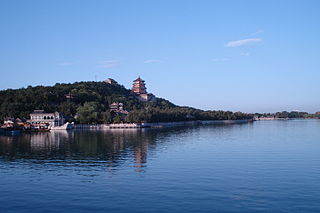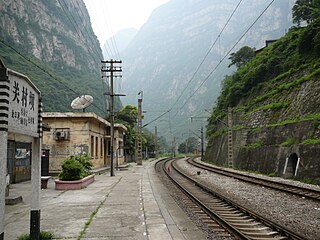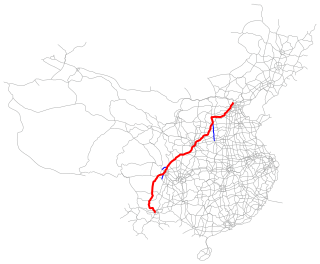
Yunnan, is a landlocked province in the southwest of the People's Republic of China. The province spans approximately 394,000 km2 (152,000 sq mi) and has a population of 48.3 million. The capital of the province is Kunming. The province borders the Chinese provinces of Guizhou, Sichuan, autonomous regions of Guangxi, and Tibet as well as Southeast Asian countries: Vietnam, Laos, and Myanmar. Yunnan is China's fourth least developed province based on disposable income per capita in 2014.

Kunming, also known as Yunnan-Fu, is the capital and largest city of Yunnan province, China. It is the political, economic, communications and cultural centre of the province as well as the seat of the provincial government. The headquarters of many of Yunnan's biggest corporations are based in the city. The city was of great significance during World War II as a Chinese military center, American air base, and transport terminus for the Burma Road. In the middle of the Yunnan–Guizhou Plateau, Kunming is at an altitude of 1,900 metres above sea level and a latitude just north of the Tropic of Cancer. As of 2020 census, Kunming had a total population of 8,460,088 inhabitants, of whom 5,604,310 lived in its built-up area made of all urban districts but Jinning, not conurbated yet. It is at the northern edge of Dian Lake, surrounded by temples and lake-and-limestone hill landscapes.

The Summer Palace is a vast ensemble of lakes, gardens and palaces in Beijing. It was an imperial garden in the Qing dynasty. Inside includes Longevity Hill Kunming Lake and Seventeen Hole Bridge. It covers an expanse of 2.9 square kilometres (1.1 sq mi), three-quarters of which is water.

Dianchi Lake, also known as Lake Dian and Kunming Lake, is a large lake located on the Yunnan-Guizhou Plateau close to Kunming, Yunnan, China. Its nickname is the "Sparkling Pearl Embedded in a Highland" and it was the model for the Kunming Lake in the Summer Palace in Beijing. Its name is the source of Yunnan's Chinese abbreviation 滇.

Thames Town is a new town in Songjiang District, about 30 kilometres (19 mi) from central Shanghai. It is named after the River Thames, which flows through London, United Kingdom. The architecture is themed according to British market town styles. There are cobbled streets, Victorian terraces, corner shops and red telephone boxes. High house prices led to few permanent residents moving to the area, causing many of the shops and restaurants to close and the area to become known as a "ghost town".

Anning is a county-level city under the jurisdiction of Kunming, the capital of Yunnan province, China. It is located approximately 28 kilometers southwest of Kunming city proper. In 1995, Anning was upgraded to a county-level city from a county.

Xishan District is one of seven districts of the prefecture-level city of Kunming, the capital of Yunnan Province, Southwest China.

The Kunming Natural History Museum of Zoology (昆明动物博物馆) is located on the campus of Kunming Institute of Zoology, Jiaochang East Road, Kunming, Yunnan, China. The museum is an important project of the Chinese Academy of Sciences Knowledge Innovation Program, and a joint project of the academy and Yunnan Provincial Government.
The Roman Catholic Archdiocese of Kunming is an archdiocese located in the city of Kunming in China.

The Shanghai–Kunming Railway or Hukun Railway, also known as the Hukun Line, is a major arterial railroad across eastern, south central and southwest China. It connects Shanghai, whose shorthand name is Hu, and Kunming. The line has a total length of 2,690 km (1,670 mi) and passes through Shanghai Municipality, Zhejiang, Jiangxi, Hunan, Guizhou and Yunnan Province. Major cities along route include Shanghai, Jiaxing, Hangzhou, Yiwu, Jinhua, Shangrao, Yingtan, Pingxiang, Zhuzhou, Huaihua, Kaili, Guiyang, Anshun, Qujing, and Kunming.

Kunming Metro, or Kunming Rail Transit, is a rapid transit system in Kunming, the capital of Yunnan Province. With a population of just over 3 million people, Kunming was one of the largest cities in China without a metro system before its construction. The system currently consists of 6 lines.

Kunming railway station is the main railway station serving the city of Kunming, Yunnan, China. It is located about four kilometres from the city centre. On March 1, 2014, a group of men and women carrying long knives rushed into Kunming Station, killed 33 people and injured 143.

Kunming Changshui International Airport is the primary airport serving Kunming, the capital of Yunnan Province, China. The airport is located 24.5 km (15.2 mi) northeast of the city center in a graded mountainous area about 2,100 m (6,900 ft) above sea level. The airport opened at 08:00 (UTC+8) on 28 June 2012, replacing the old Kunming Wujiaba International Airport, which was later demolished. As a gateway to Southeast and South Asia, Changshui Airport is a hub for China Eastern Airlines, Kunming Airlines, Lucky Air, Sichuan Airlines and Ruili Airlines.

The Chengdu–Kunming railway or Chengkun railway, is a major trunkline railroad in southwestern China between Chengdu, the capital of Sichuan Province and Kunming, the capital of Yunnan Province. The line is 1,134 km (705 mi) long and traverses rugged terrain from the Sichuan Basin to the Yunnan-Guizhou Plateau. The line was built between 1958 and 1970, with much of the work coming during the Third Front campaign to develop industry in China's interior. Major cities along route include Chengdu, Pengshan, Jiajiang, Emei, Ebian, Ganluo, Xide, Xichang, Dechang, Miyi and Panzhihua in Sichuan Province and Yuanmou, Lufeng, Anning and Kunming in Yunnan Province.

The Beijing–Kunming Expressway, designated as G5 and commonly referred to as the Jingkun Expressway is an expressway that connects the cities of Beijing, and Kunming, in Yunnan province. It is 2,865 km (1,780 mi) in length. As of 2018, the expressway has been completed in its entirety.

The Nanning–Kunming railway, or Nankun railway, is a single-track electrified railway in Southwest China between Nanning and Kunming, provincial capitals, respectively, of Guangxi Zhuang Autonomous Region and Yunnan Province. The railway was built from December 24, 1990, to March 18, 1997, and has a total length of 898.7 km (558 mi), including the main line of 863.04 km (536 mi) between Nanning and Kunming and a branch line from Weishe Township of Xingyi City to Hongguo Township of Liupanshui municipality, in Guizhou province. The Nankun Railway is a major rail conduit in Southwest China. Major cities and towns along route include Nanning, Baise, Xingyi, Luoping and Kunming.

On 1 March 2014, a group of 8 knife-wielding terrorists attacked passengers in the Kunming Railway Station in Kunming, Yunnan, China, killing 31 people, and wounding 143 others. The attackers pulled out long-bladed knives and stabbed and slashed passengers at random. Four assailants were shot to death by police on the spot and one injured perpetrator was captured. Police announced on 3 March that the six-man, two-woman group had been neutralized after the arrest of three remaining suspects.
Zhang Tianxin is a former Chinese politician, and Communist Party Secretary of Kunming, the provincial capital of Yunnan Province, between 2011 and 2014. He was dismissed from his position in July 2014, after he came under investigation for violating "party discipline", and subsequently expelled from the Chinese Communist Party.

Changsha–Kunming high-speed railway is a China Railway High-speed line connecting Changsha and Kunming, respectively the provincial capitals of Hunan and Yunnan. It is the western end of a larger rail project, the Shanghai–Kunming high-speed railway, which is one of the Ministry of Railways's strategic four east–west high-speed railways, and an integral part of the long-term railway network plan.

The Kunming–Yuxi–Hekou railway is a standard-gauge railway in Yunnan Province of China, linking the provincial capital Kunming with the town of Hekou on the Vietnamese border. Constructed in several stages between 1989 and 2014, the Kunming–Yuxi–Hekou railway has largely replaced the Chinese section of the old metre-gauge Kunming–Haiphong railway for normal passenger and cargo transportation. The line is electrified, but single-tracked over most of its length.

















